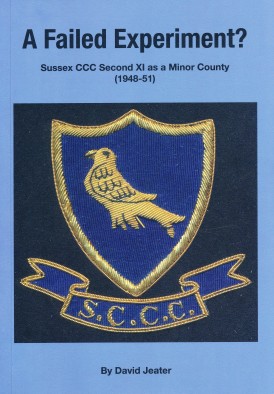A Failed Experiment?
Martin Chandler |Published: 2018
Pages: 42
Author: Jeater, David
Publisher: Sussex Cricket Museum
Rating: 3.5 stars

The latest in the Sussex Cricket Museum’s series of limited edition booklets is something that probably won’t appeal to the vast majority of the rank and file of the county’s members, yet this reviewer, Lancastrian to the core, found it fascinating.
Sporting allegiances are a strange thing. In football you support your club, whoever they may be, perhaps have a soft spot for another one or two at most and, to varying degrees, either detest the rest or look on them with supreme indifference. At least that is the way the beautiful game strikes me.
As far as the even more beautiful game is concerned being a supporter is rather different. Of course I always want the Red Rose to win, whoever they are playing, but to a greater or lesser extent my soft spot extends to all of the other 17, even Yorkshire. The county game is a wonderful thing, and those of us who follow it enjoy a rich camaraderie, wherever our spiritual home may be. As a result the histories of all the other counties is a source of fascination to me, and the story of a four summer excursion into the Minor Counties Championship by Sussex is something that is of considerable interest.
My enthusiasm may, I suppose, have something to do with the way the First Class game has been marginalised by the ECB, banished to the front and back ends of the season to accommodate the game’s shorter formats It may however simply be the inexorable march of Anno Domini, but it does seem that the older I get the more all of the counties and their long histories appeal to me.
One aspect of county cricket that has never received the attention it deserves from the game’s writers is subject of second elevens. Nowadays every county has one actively engaged in various competitions, but it wasn’t always so. The Second Eleven Championship itself has only been contested since 1959, and before that, in 1948 for example, any county second eleven that wanted some degree of competitive cricket other than just playing what amounted to friendly matches had to compete in the Minor Counties Championship. That year there were just eleven of them including, for the first time, Sussex.
By 1952 Sussex II were gone, not to reappear in Wisden until the end of the decade when the Second Eleven Championship began. The reason the Sussex experiment failed, unsurprisingly, was the austerity of the time and the story of the venture is not a complicated one. The booklet however has something of everything that is good about cricket literature; original research, an interesting story well told and a splendid production entirely in keeping with the standards the museum has set for itself in the past.
As to what A Failed Experiment? comprises that is essentially what a reader would expect. There is a chapter giving some background, followed by four summarising each of those largely unsuccessful summers in the Minor Counties Championship followed by the obligatory summing up and retrospective. The committee minutes, to which Jeater had access, were not as expansive as he or his reader might have liked but, assisted by the memories of surviving Sussex players of the time, the story is all here.
In addition to the narrative there are potted scores for each of the 48 matches played over the four seasons, brief biographical details of each of the 68 men who turned out for the side and an interesting selection of photographs. Men like David Sheppard, Jim Parks and Alan Oakman have familiar faces, but not looking as young as they do in the images that illustrate A Failed Experiment?
This splendid booklet appears in a numbered limited edition of 100 copies signed by both Jeater and Parks. As I wrote at the outset A Failed Experiment? won’t appeal to all, but I would think there will be more than enough cricket tragics to ensure this one sells out with indecent haste, so early purchasing at the relatively modest cost of £15 plus £2 postage is encouraged, particularly as all profits will go into the museum’s coffers to assist it in giving pleasure to those who enter its portals, conveniently situated at the County ground in Hove.






Leave a comment